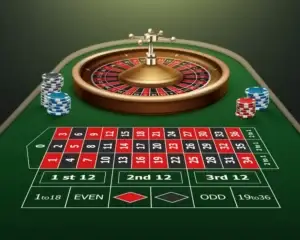When you hear the word “roulette”, your imagination probably paints scenes of luxury, excitement and sincere emotions. It’s no wonder: the game, which has gained popularity around the world, is associated with the glitz of the casino and the hope of instant wealth. But before you rush into the maelstrom with your head, analyze the nuances and features that can significantly affect your success. In this article we will analyze in detail the rules of roulette, types of bets and touch on other aspects of the topic.
Equipment for playing roulette
Roulette takes its name from the French word “roulette”, meaning “small wheel”. This wheel is the centerpiece of the game. It contains numbers from 1 to 36, as well as a sector with a zero. In the American version, another sector with double zero “00” is added. The dealer, also called the croupier, spins the wheel and throws a small white ball on it, which eventually stops on one of the sectors. The betting table features a variety of options, from specific numbers to color and number groups, allowing players to choose a game strategy that suits their taste and goals.
Types of roulette bets
 It is important for the player to know not only the rules of roulette, but also the peculiarities of the bets that exist in the game. Let’s consider in detail.
It is important for the player to know not only the rules of roulette, but also the peculiarities of the bets that exist in the game. Let’s consider in detail.
Internal
These are made directly on specific numbers inside the game grid. They have a high win rate, but their probability is quite low. Here are the main types:
- Direct on a selected number from 0 to 36. The payout is 35 to 1, and this is one of the riskiest, but also the most profitable bets.
- Double number bet (Split): the player places a chip on the border of two neighboring numbers, for example, 8 and 11. If one of the numbers falls, the sum comes out to 17 to 1. This is a good way to increase the odds of winning while keeping the odds relatively high.
- On three consecutive numbers in a single line, for example, 13, 14 and 15. The chip is placed at the beginning of this line. If successful, the payout is 11 to 1.
- Corner (Corner or Kare): the chip is placed on the intersection of four numbers such as 1, 2, 4 and 5. The sum comes out to 8 to 1, which allows you to increase the odds, but with lower odds.
- Bet on six numbers: the player places a chip on the intersection of two lines of numbers, thus covering six numbers, for example, 28-33. If the player wins, the payout will be 5 to 1. This is a compromise between risk and chance of winning.
American roulette also includes a five number bet (0, 00, 1, 2, 3) which has a payout of 6 to 1. However, because of the double zero, it is one of the riskiest and in this case, the advantage is always on the side of the casino.
External
Give a higher chance of success, but a lower win rate. Includes:
- Betting on color. The choice is between red and black. If the bet wins, the payout ratio is 1:1.
- Parity. Placing a bet on an even or odd number on the wheel. The payout on a win is also 1:1.
- On one of the dozens. The player chooses one of three groups of numbers – the first (1-12), the second (13-24) or the third (25-36). If successful, the payout will be 2:1.
- Per column. The chip is placed at the end of one of the three columns on the gaming table, each of which consists of 12 numbers. The payout for such a bet is 2:1.
Probabilities and casino advantage
Every casino game has a built-in edge, and roulette is no exception. In the European variation, the advantage is 2.7% thanks to the sector 0. In the American variation, 00 is added and the advantage rises to 5.6%. These sectors provide a mathematical advantage to the casino, regardless of the type of bet. There are many myths that you can predict the outcome of a game by watching the dealer or studying certain patterns. However, roulette is based on randomness, and each spin is an independent event, which makes any attempts at prediction ineffective. It is enough just to study well the rules of roulette, basic strategies, types of bets to approach the probability of a successful outcome of the game.
Rules of roulette: how to play
Choosing a table, the game process, the peculiarities of the relationship with the dealer – all this is mandatory to study if you want to turn from a beginner into a cool pro.
Table selection
Each roulette table has minimum and maximum bets that must be respected by players. It is important to realize that inside bets tend to have a higher win rate, and therefore the limits for them are lower than for outside bets.
How the rounds are played
The roulette game is played as follows: the dealer announces the start of the round, and players begin to place their bets by placing chips on the table. Then the croupier starts the wheel and throws the ball. As soon as the ball starts to slow down, the dealer announces: “Betting is done, no more bets.” After the ball stops, the dealer marks the winning number, collects the losing bets and pays out the winnings.
La Partage” and “En Prison” roulette rules
These rules apply in some variants of French Roulette and help players to reduce losses on outside bets. “La Partage” allows you to return half of your bet if you hit 0, while “En Prison” allows you to keep it for the next spin.
Rules of behavior and interaction with the dealer in roulette
During the game, each player uses chips of a certain color to make it easier for the dealer to distinguish bets. When the game is over, these are exchanged for regular casino chips, which have a face value and can be used outside of the roulette table. It is important to remember that watching the actions of the dealer or other players will not affect your luck – roulette remains a game based purely on chance.
Memorize the rules of roulette and go for it!
 Each spin of the wheel – a new chance, but also another test of luck. If after reading this article you feel the desire to test your own strength – try. But before that, make sure that well memorized the rules of roulette.
Each spin of the wheel – a new chance, but also another test of luck. If after reading this article you feel the desire to test your own strength – try. But before that, make sure that well memorized the rules of roulette.
And remember: any gambling – entertainment, which can bring a lot of money, but still it is not the main source of income. Do not bet too much, play confidently and enjoy the process.
 en
en  de
de  ar
ar  es
es  hi
hi  fr
fr  nl
nl  it
it  pt
pt  el
el 









